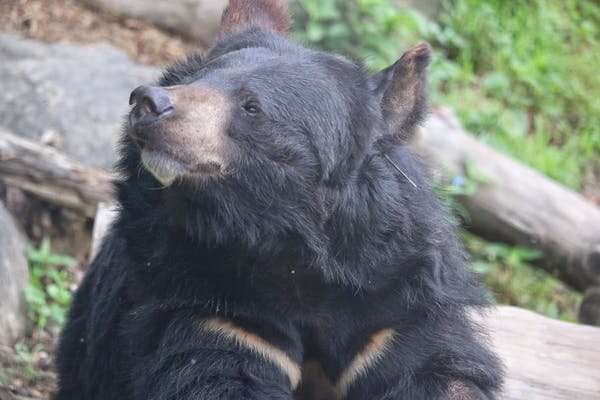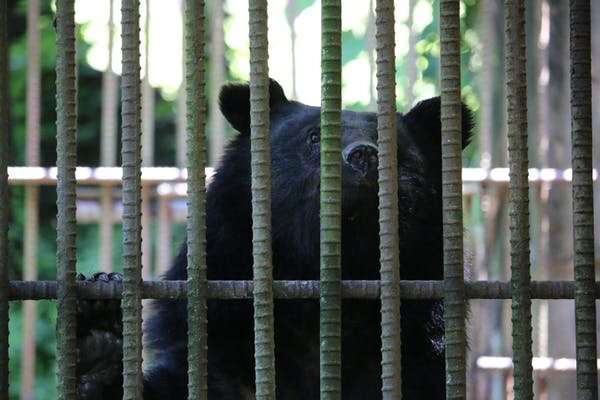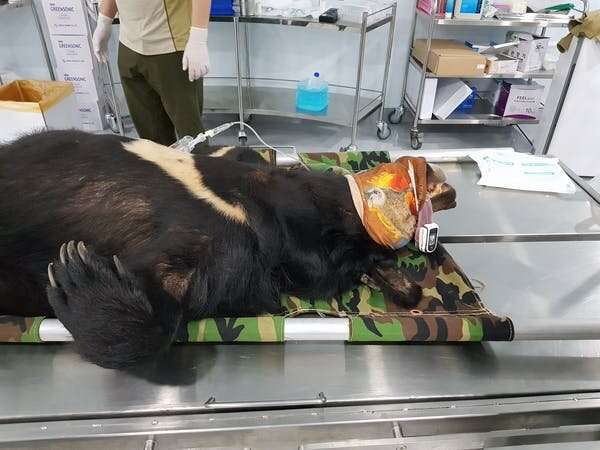The Asiatic black bear (Ursus thibetanus), or moon bear. Credit: Joshua Powell, Author provided
The return of wolves to Yellowstone National Park in 1995 popularized the idea of reintroducing long-lost species to modern habitats. While scientists are still trying to fully understand the ecological consequences, the wolf's reintroduction likely benefited other species, illustrating how conservation can not just slow biodiversity loss, but even reverse it.
That project, however, took place in a vast protected wilderness. Many of the places where biologists now hope to reintroduce large wild animals—whether it's lynx in Britain or cheetahs in India—are a little closer to where people live, with all of the potential problems that entails in terms of human-wildlife conflict.
In South Korea, a country of similar size and similar human population density to England, conservationists are in the process of restoring the native bear population, Asiatic black bears, or moon bears, to be precise. While slightly smaller than their North American cousins, these are still large wild animals, capable of causing fear and alarm and posing a risk to human life and property.
I wanted to find out how South Korea is managing this ambitious project, so I traveled to Jirisan National Park, a mountainous region in the far south of the Korean Peninsula.
By the 1990s, along with occasional sightings in the Demilitarized Zone (DMZ), Jirisan had become the last foothold of the Asiatic black bear in South Korea. An attempted eradication program by the colonial Japanese regime of the early 20th century and overhunting following independence in 1945 meant bears had fared badly for some time. At the close of the century, there were thought to be just five wild bears left in the country, and the species was on the brink of extinction in South Korea.
A captive Asiatic black bear on a disused bear bile farm in Gangwon-do, South Korea. Credit: Joshua Powell, Author provided
These were not the only bears in the country though. A large population lingered on farms producing bear bile and body parts, which are used in traditional medicine, and bear meat. Since the 1990s, South Korea has cracked down on the bear part trade, but the remaining population of around 380 captive bears still substantially outnumbers those in the wild (around 70 in 2021).
These farm bears might have seemed the ideal animals to rebuild a wild population. But the bears probably belonged to a range of different subspecies and were potential disease risks. Years of being fed by humans also meant that the bears could seek out contact—and cause conflict—with humans. Instead, bears were imported from China, Russia and North Korea. In 2004, the first six cubs were released into Jirisan.
Why did South Korea's bear program succeed?
No grand claims were made about reshaping the relationship between humans and the natural world, and no changes were promised to centuries-old methods of managing landscapes, ideas which often feature in debates about rewilding. Instead, conservationists in South Korea established a modest initial goal: returning a population of 50 bears to a single protected area.
Veterinarians prepare to transport a female bear following examination. Credit: Joshua Powell, Author provided
Soft releases, in which bears are kept in pens to acclimate to their surroundings before being set free, and extensive monitoring of bears post-release, helped increase the likelihood of each released bear surviving. Bears that strayed too far were returned to the national park.
Captive breeding, underpinned by impressive veterinary expertise, has also helped the population grow. One milestone involved the world's first successful use of artificial insemination in this genus of bear, a boon for maintaining genetic diversity in a small population. Bears injured by snares or traffic collisions have also been successfully returned to the wild.
The initial target of 50 bears was exceeded and the population now stands at over 70. A recent study found that some bears were now dispersing across South Korea, suggesting that Jirisan National Park may be close to reaching the limit of bears it can sustain.
This presents new challenges. Conservationists have, so far, been remarkably successful at reducing conflict between bears and people, and building support for restoring bears to Jirisan National Park with education programs, presentations for residents and hikers, a center where visitors can learn about the reintroduction program and even the use of moon bear mascots for the 2018 Pyeongchang Winter Paralympics.
Bukhansan National Park, near Seoul. Once home to leopards and tigers, could these mountains see bears again? Credit: Joshua Powell, Author provided
But the appearance of bears outside of the national park still attracts prime-time media coverage, which can hamper efforts to cultivate tolerance and maintain a reasonable dialog with the public about the realities of living alongside bears. People feeding bears remains an issue, as does illegal snaring for game species, which can severely injure bears. As South Korea reaches the next stage of its reintroduction program, is the country prepared to accept bears outside of a protected area?
It will be fascinating to follow these bears over the coming years as conservationists address these questions. And Asiatic black bears are just the start. South Korea has since established programs to restore the red fox, which is surprisingly rare in the country, and the long-tailed goral, a goat-like mammal whose populations have been depleted by poaching and habitat loss.
These programs will face challenges, but South Korea has shown considerable expertise in the field of mammal reintroductions. Expertise that other countries could well learn from.
Provided by The Conversation
This article is republished from The Conversation under a Creative Commons license. Read the original article.![]()


























